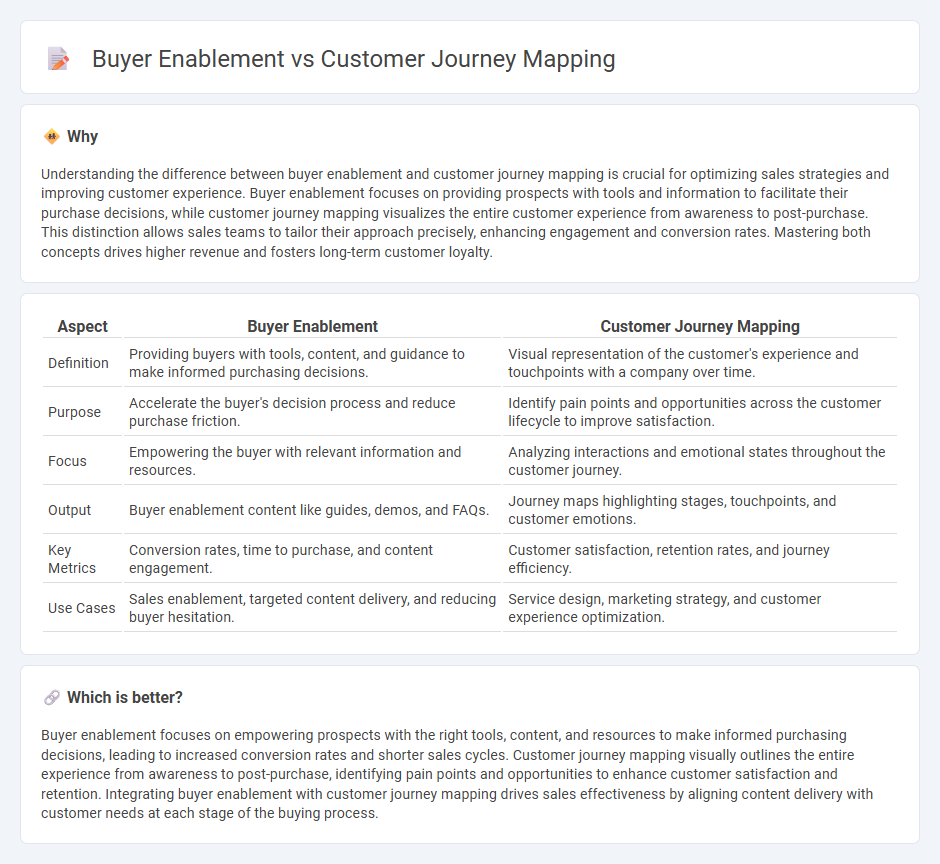
Buyer enablement focuses on equipping prospects with the right tools and information to make informed purchasing decisions, enhancing both confidence and efficiency. Customer journey mapping visually outlines each touchpoint a buyer experiences, highlighting opportunities to improve engagement and satisfaction across channels. Discover how aligning buyer enablement with customer journey mapping can transform your sales strategy and drive measurable growth.
Why it is important
Understanding the difference between buyer enablement and customer journey mapping is crucial for optimizing sales strategies and improving customer experience. Buyer enablement focuses on providing prospects with tools and information to facilitate their purchase decisions, while customer journey mapping visualizes the entire customer experience from awareness to post-purchase. This distinction allows sales teams to tailor their approach precisely, enhancing engagement and conversion rates. Mastering both concepts drives higher revenue and fosters long-term customer loyalty.
Comparison Table
| Aspect | Buyer Enablement | Customer Journey Mapping |
|---|---|---|
| Definition | Providing buyers with tools, content, and guidance to make informed purchasing decisions. | Visual representation of the customer's experience and touchpoints with a company over time. |
| Purpose | Accelerate the buyer's decision process and reduce purchase friction. | Identify pain points and opportunities across the customer lifecycle to improve satisfaction. |
| Focus | Empowering the buyer with relevant information and resources. | Analyzing interactions and emotional states throughout the customer journey. |
| Output | Buyer enablement content like guides, demos, and FAQs. | Journey maps highlighting stages, touchpoints, and customer emotions. |
| Key Metrics | Conversion rates, time to purchase, and content engagement. | Customer satisfaction, retention rates, and journey efficiency. |
| Use Cases | Sales enablement, targeted content delivery, and reducing buyer hesitation. | Service design, marketing strategy, and customer experience optimization. |
Which is better?
Buyer enablement focuses on empowering prospects with the right tools, content, and resources to make informed purchasing decisions, leading to increased conversion rates and shorter sales cycles. Customer journey mapping visually outlines the entire experience from awareness to post-purchase, identifying pain points and opportunities to enhance customer satisfaction and retention. Integrating buyer enablement with customer journey mapping drives sales effectiveness by aligning content delivery with customer needs at each stage of the buying process.
Connection
Buyer enablement enhances customer journey mapping by providing insights into buyer behaviors, preferences, and pain points, allowing sales teams to tailor strategies effectively. Detailed customer journey mapping identifies critical touchpoints where buyer enablement tools such as content, training, and resources can accelerate decision-making and improve engagement. Integrating these processes boosts sales performance by aligning sales efforts with the buyer's needs and streamlining the path to purchase.
Key Terms
**Customer Journey Mapping:**
Customer Journey Mapping visually represents each stage a customer experiences when interacting with a brand, highlighting pain points and opportunities for engagement. It integrates data from touchpoints such as awareness, consideration, purchase, and post-purchase to optimize customer satisfaction and drive loyalty. Explore more to understand how strategic mapping enhances customer experiences and business growth.
Touchpoints
Customer journey mapping identifies and visualizes key touchpoints where potential buyers interact with a brand, helping businesses understand customer behavior and pain points. Buyer enablement enhances these touchpoints by providing targeted content, tools, and resources that empower buyers to make informed decisions throughout the purchase process. Explore how optimizing touchpoints through these strategies can boost engagement and conversion rates.
Pain Points
Customer journey mapping identifies critical pain points by tracing each stage of the buyer's interaction with a brand, revealing barriers that hinder progress and cause dissatisfaction. Buyer enablement addresses these pain points directly by providing tailored resources, tools, and guidance designed to help buyers overcome obstacles and make informed purchasing decisions. Explore how integrating both strategies can optimize customer satisfaction and sales outcomes.
Source and External Links
The customer journey map and why it's important - A customer journey map is a visual representation of every point of contact between customers and a company throughout their relationship, analyzing actions, emotions, and pain points to identify improvement opportunities.
What is a Customer Journey Map? - IBM - It illustrates every experience a customer has with a brand, product, or service, highlighting key stages, touchpoints, emotions, and pain points across the journey, often validated with real customer data.
30 Best Customer Journey Mapping Tools of 2025 - Customer journey mapping can be done using various tools and methods, from freeform drawings to specialized software, focusing on tracking discovery, purchase, usage, feedback, and churn to capture the full experience.
 dowidth.com
dowidth.com